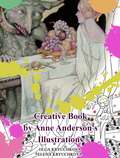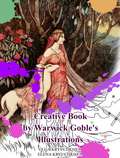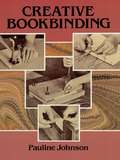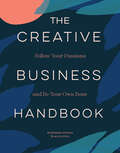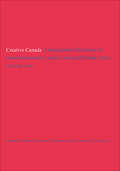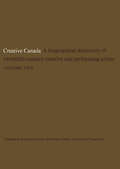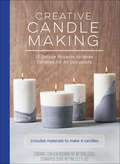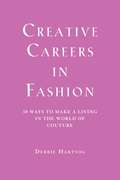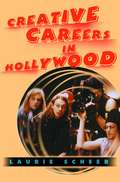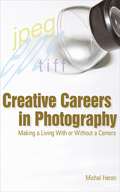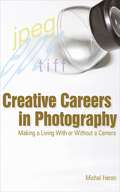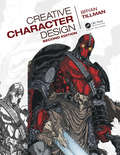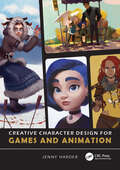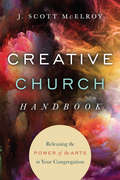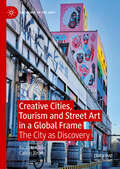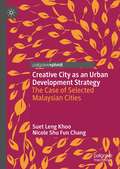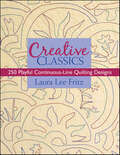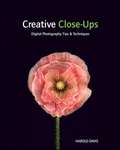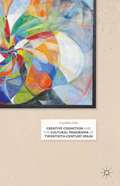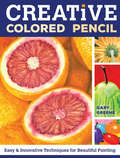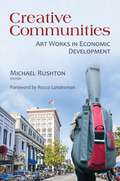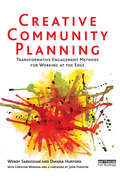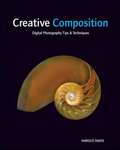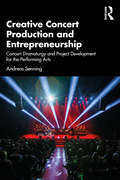- Table View
- List View
Creative Book by Anne Anderson's Illustrations
by Olga Kryuchkova Elena KryuchkovaAnne Anderson (1874-1952) is a British artist who specialized in illustrating children's literature, collaborated with various periodicals, and painted greeting cards. Anne was born in 1874 in Scotland. She had four brothers and a sister, Grace. They spent their childhood in Argentina. But having reached adulthood, Anne and Grace returned to England in search of work. In 1912, Anne Anderson married the artist Alan Wright (1864-1959). Later, her husband helped Anna with her illustrations. Throughout her life, the artist has illustrated many tales, including works by Charles Perrault, the brothers Grimm and Hans Christian Andersen. Data on the death of Anne diverge. Some sources indicate 1930, others 1936, and still others indicate that she was alive at the end of World War II. But according to church records in Berkshire, the date of the death of the artist is still considered to be May 26, 1952. This creative book is dedicated to Anne Anderson's illustrations. Here you will find a color image and a monochrome image with color swatches. If desired, you can take a screenshot from a black and white image to colorize it on a computer or print it on a printer and colorize it on paper. When coloring, you can focus on a color swatch and color swatches, or you can choose your own color solutions for coloring. The creative book has no age restrictions. Wish you creative success and enjoy your time! This book can be used as a coloring book-atistress or art therapy.
Creative Book by Warwick Goble's Illustrations
by Olga Kryuchkova Elena KryuchkovaThis creative book is dedicated to Warwick Goble's illustrations. Here you will find a color image and a monochrome image with color swatches. If desired, you can take a screenshot from a black and white image to colorize it on a computer or print it on a printer and colorize it on paper. When coloring, you can focus on a color swatch and color swatches, or you can choose your own color solutions for coloring. The creative book has no age restrictions. Wish you creative success and enjoy your time! This book can be used as a coloring book-atistress or art therapy.
Creative Bookbinding
by Pauline Johnson"Unusually well done and informative." -- Lafayette (Indiana) Journal & CourierA book bound by hand can be a work of art in a way that machine-bound books can never be. And in this comprehensive, profusely illustrated guide to hand bookbinding, a noted expert in the field explains the techniques needed to create your own choice specimens of the binder's art. Directed especially toward beginners, Creative Bookbinding shows how this ancient craft offers a satisfying hobby and rewarding aesthetic experience -- even for those with little previous knowledge of the craft. As Pauline Johnson states in the Preface: "Even with a limited background of knowledge [the craftsperson] can experience a great deal of enjoyment in binding his own books and building up a distinctive personal library of which he can be proud. Each product can be an artistic creation to be cherished."Detailed illustrated instructions for achieving such beautiful hand-crafted volumes are presented here in a readable, informal, and easy-to-follow format. After a brief history of printing and binding, the author provides an in-depth discussion of book design -- the proportion and size of books, the parts of a book, materials, tools, and equipment needed for book construction ( a list of supply sources is included), and more. Working procedures are clearly explained, progressing from binding simple folders, notepads, folios, pamphlets, and magazines to full-size sewn books with bindings of cloth and leather. You'll also find an indispensable chapter on the preservation and repair of valuable or irreplaceable volumes.Over 600 photographs and diagrams explain and clarify each step of each process, as well as depicting an abundance of beautiful bindings, both ancient and modern. With this book as a guide, bookbinders at all skill levels can strive to achieve similar magnificent results.
Creative Business Handbook: Follow Your Passions and Be Your Own Boss
by Alicia Puig Ekaterina PopovaOffering veteran insight and friendly, actionable advice from two self-made women who manage three six-figure businesses, this practical handbook acts as a roadmap to guide anyone wanting to build a profitable venture out of their creative passion.Figuring out how to make a living from your creative work poses unique challenges and obstacles. From choosing the right business model to building a brand, from managing your time to scaling up your production—starting your own creative business often means doing it all yourself. Enter The Creative Business Handbook by Alicia Puig and Ekaterina Popova, the dynamic duo behind Create! Magazine.With its conversational tone and accessible advice, this handbook lays an essential foundation for anyone wanting to earn a living with their art—no fancy business degree required! In addition to nuts-and-bolts advice based on the authors' real-life experiences, each chapter of the book includes an interview with a creative entrepreneur from a different background and craft, and ends with action steps that will help keep you on track. Written by creative business owners for creative business owners, this is the perfect book for anyone with a vision who is ready to hit the ground running.EXPERT AUTHORS: Informed by the authors' decades of experience founding and managing three successful creative businesses—as well as the lessons they learned from some projects that didn't stand the test of time—this book offers tried-and-true advice for artists looking to get their creative enterprises off the ground and achieve real financial success. Popova and Puig have also included interviews with other self-employed creatives across a variety of fields, giving you a window into the myriad paths available to you as you embark on your entrepreneurial journey.FOR ALL CREATIVES: This book offers real wisdom for starting and sustaining your unique creative business no matter your passion, whether you are a career artist looking to make a living outside of the gallery space, an experienced freelance writer interested in mentoring your peers, or a podcaster who dreams of sustaining yourself by making content that you genuinely care about. From advice about best marketing practices to striking the ever-elusive work-life balance, this guide will help you to understand the business side of your creative practice.Perfect for:Artists, designers, makers, illustrators—recent graduates and budding professionals—looking to start their own businessesCreative people exploring career ideas and looking for practical advice and inspirationGraduation, birthday, or holiday gift for artistic and entrepreneurial friends and loved onesReaders of Create! Magazine, Steal Like an Artist, Big Magic, and Untamed
Creative Canada: A Biographical Dictionary of Twentieth-Century Creative and Performing Artists (Volume #1)
by Reference Division, McPherson Library, University of VictoriaDid he ever play Hamlet? Has she worked in television? What was the title of his first novel? Under whom did she study? How many children has he? Answers to such questions about contemporary Canadian artists have often been difficult, even impossible, to find. This series has been created to provide the answers; it covers creative and performing artists who have contributed as individuals to the culture of Canada in the twentieth century.Each volume in the series presents a cross-section of many different kinds of artists: authors of imaginative works, artists and sculptors, musicians (performers, composers, conductors, and directors), and performing artists in ballet, modern dance, radio, theatre, television, and motion pictures; directors, designers, and producers in theatre, cinema, radio, television, and the dance; choreographers and, for cinema, cartoonists and animators. Within each category of art is included a selection of those who have achieved national and international recognition; those who have been recognized locally, and some, now deceased, who markedly influenced their contemporaries locally, nationally, or internationally. This is not a critical compilation; rather it is an objective and factual reference work for those interested in contemporary Canadian culture. Information was collected by painstaking research in a wide variety of sources, and wherever possible it has been verified by the artist to make each entry as accurate and comprehensive as possible.
Creative Canada: A Biographical Dictionary of Twentieth-century Creative and Performing Artists (Volume #2)
by Reference Division, McPherson Library, University of VictoriaDid he ever play Hamlet? Has she worked in television? What was the title of his first novel? Under whom did she study? How many children has he? Answers to such questions about contemporary Canadian artists have often been difficult, even impossible, to find. This series has been created to provide the answers; it covers creative and performing artists who have contributed as individuals to the culture of Canada in the twentieth century. Each volume in the series presents a cross-section of many different kinds of artists: authors of imaginative works, artists and sculptors, musicians (performers, composers, conductors, and directors), and performing artists in ballet, modern dance, radio, theatre, television, and motion pictures; directors, designers, and producers in theatre, cinema, radio, television, and the dance; choreographers and, for cinema, cartoonists and animators. Within each category of art is included a selection of those who have achieved national and international recognition; those who have been recognized locally, and some, now deceased, who markedly influenced their contemporaries locally, nationally, or internationally. This is not a critical compilation; rather it is an objective and factual reference work for those interested in contemporary Canadian culture. Information was collected by painstaking research in a wide variety of sources, and wherever possible it has been verified by the artist to make each entry as accurate and comprehensive as possible.
Creative Candle Making: 12 Unique Projects to Make Candles for All Occasions
by Meredith MennittLearn the enchanting art of making candles and enjoy your creations all year long.Creative Candle Making instructs readers on how to make all-natural candles at home. The beautiful book leads you through twelve candle projects as well as discussing the benefits of different waxes, wicks, molds, and the history of candle craft. Learn to make a variety of candles from sweet floating candles to modern cement pillar candles. You&’ll be able to create delightful candles for every season, from Candy Cane Candles and Beeswax Forest Candles to Beach Bum Sand Candles and Apple Cinnamon Votive Candles
Creative Careers in Fashion: 30 Ways to Make a Living in the World of Couture
by Debbie HartsogWant to become a fashionista--for real? Get this book! Fun and entertaining, Creative Careers in Fashion reveals how the fashion industry works--and explores the vast range of career opportunities in the field. Focusing on the most creative jobs, including accessory, costume, and fashion design, as well as make-up artists, wardrobe consultants, textile designers, and colorists, this book showcases the practical information that will help readers find the perfect job and get it. Included are details on salary ranges, educational and experience requirements, where jobs are located, and new trends. Cameo interviews with real-life fashion professionals offer insider tips. Comprehensive, practical, and inspiring, Creative Careers in Fashion is the complete guide to finding a new career in an exciting industry. * Start a new career with help from industry insiders * Dozens of creative careers for students, career changers, anyone looking for their new parachute * Resources include detailed school and college listings.
Creative Careers in Hollywood
by Laurie ScheerReaders will discover real-life, yet upbeat portraits of the "shredder" jobs of the industry, such as assistant or d-girl, and how they can lead to the "keeper" jobs of actor, agent, or studio executive. Each career overview features a clever analysis of the classic film characters who memorably played these jobs on screen; an insightful rewards-risks assessment of the job; and a brief look at such essential job qualities as durability, length of stay, "food chain value" and desirability factor. Part how-to guide, part historical document, and part social commentary, this book will delight career seekers, Hollywood insiders, and film aficionados alike!
Creative Careers in Photography: Making a Living With or Without a Camera
by Michal HeronHeron, a freelance photographer of three decades, offers details on the diverse paths available to aspiring career photographers. Jobs considered fall under one of stock categories: publication, consumer, service, digital, stock, or fine art photography, each of which is complemented by an interview with a practitioner. Also addressed are non-camera photography careers such as buying and dealing, representing, and writing or teaching. Advice mainly comprises job and equipment descriptions-- the author forgoes speculations on employment and salary outlook. The book concludes with advice on career building and self-marketing and a list of institutions teaching photography and professional organizations for photographers. Annotation ©2007 Book News, Inc. , Portland, OR (booknews. com)
Creative Careers in Photography: Making a Living with or Without a Camera
by Michal HeronFind the right job in photography. For anyone who loves working with photographs, here is a comprehensive guide to turning that passion into a career. Author Michal Heron, a veteran photographer, reveals the full range of possibilities, from shooting pictures to jobs that don't even require a camera. Corporate settings, editorial, media/audio-visual, fine arts, buying and selling, support services, set and location services, computer imaging, gallery and museum, teaching, writing, and many other career choices are presented. Readers will learn to assess their motivations, pinpoint their favorite areas of photography, explore lifestyle choices, understand required skills, and ultimately find the area of the industry that best matches their talents and their goals. Extra resources include listings for photography schools and professional organizations. Anyone looking for that perfect niche in the rich and rewarding photographic field will need this comprehensive book. Examines dozens of career possibilities-many that don't require a camera Self-assessment tools to pinpoint the perfect job, plus school and organization listings
Creative Character Design 2e
by Bryan TillmanCreate compelling, original characters using archetypes and design elements such as shadows and line with the tips and techniques found in this image-packed book. Bryan Tillman bridges the gap between the technique of drawing characters and the theory of good character design by using case studies, examples of professional art, and literary and pop culture references to teach you how to develop a character, not just draw one. The book also features Character Model Sheets that will guide you through the creation of new and unique characters. Finally, Bryan will break down established character archetypes to show you why and how the different aspects of good character design work. <P><P>Key Features: <li>Learn what makes a character unique and powerful through tools like character model sheets and case studies from established artists. <li>Develop your ability to use story and archetypes to create compelling new characters. <li>See artwork by professional artists as examples of the techniques shown in the book <li>Bridges the gap between the technique of drawing characters and the theory of good character design in a practical, hands-on way - learn how to use story and archetypes to develop compelling, new characters <li>Based on a standing-room only presentation at Comic-Con 2009 in San Diego.
Creative Character Design for Games and Animation
by Jenny HarderThis book takes you through all the basic steps of character design for games and animation, from brainstorming and references to the development phase and final render. It covers a range of styles such as cartoon, stylized and semi-realistic, and explains how to differentiate between them and use them effectively. Using a step-by-step approach for each stage of the process, this book guides you through the process of creating a new character from scratch. It contains a wealth of design tips and tricks as well as checklists and worksheets for you to use in your own projects. This book covers how to work with briefs, as well as providing advice and practical strategies for working with clients and creating art as a product that can be tailored and sold. This book will be a valuable resource for all junior artists, hobby artists, and art students looking to develop and improve their character development skills for games and animation.
Creative Church Handbook: Releasing the Power of the Arts in Your Congregation
by J. Scott McElroyMobilizing and managing artists and other creatives in your congregationEstablishing structures and parameters for arts ministryLeading and supporting staff and church members in creative changesEnhancing the worship serviceAdding creative elements to your sermonsEngaging the broader community
Creative Cities, Tourism and Street Art in a Global Frame: The City as Discovery (Sociology of the Arts)
by Ricardo Klein Caitlin BruceThis book explores the use of street art tourism in eight cities: Barcelona, Paris, Porto, Pittsburgh, Cleveland, Montevideo, Bogota and Buenos Aires. While street art and graffiti are perpetually in the process of being discovered by scholars and cultural programmers as a practice full of potential, these contributions offer context and grounding and ask how, in a global setting, such art is used in tandem with tourism practices to interpret, codify, and make value out of space through institutional and community networks.
Creative City as an Urban Development Strategy: The Case of Selected Malaysian Cities
by Suet Leng Khoo Nicole Shu ChangThis book is a pioneering work to position the creative city concept within Malaysian urban development discourse. The chapters are written and systematically sequenced to be all-encompassing and comprehensible to audiences both from the academic and non-academic realms. The nascency of creative city development in Malaysia has motivated the timely exploration of the viability of this strategy for selected Malaysian cities (i.e. Kuala Lumpur, George Town, Ipoh, Johor Bahru). The book also discusses the global discourse on creative city and its critiques. This is followed by an overview of Malaysia’s macrolevel socio-economic and political structures as well as national policies to frame the Malaysian creative city narrative. The case study chapters are novel, as each Malaysian city unravels its unique experiences and dissects the way the city responds to the creative city agenda amidst local nuances and idiosyncrasies.
Creative Classics: 250 Playful Continuous-Line Quilting Designs
by Laura Lee FritzRev Up Your Hand or Machine Quilting With Fresh Versions of Favorite Motifs n Recharge the old favorites with 250 playful new continuous-line variations on 5 classic quilting motifs n Add style to individual blocks, sashings, and borders, or use as overall quilting designs n All motifs work for both hand and machine quilting, and for long-arm as well as short-arm machines Make your quilt sing with these exuberant new variations on 5 classic quilting motifs. Master quilter Laura Lee Fritz shows you dozens of fresh takes on clamshells, waves, serpentines, Baptist fans, and feathers.
Creative Close-Ups
by Harold DavisThe essential guide for digital macro photographers everywhereThe art of macro photography-photographing small objects or super close-ups of small sections of big objects-yields fascinating results, but shooting at this level brings its own set of challenges. Now you can shoot close-ups with confidence and creative flair with this information-packed guide. Renowned photographer Harold Davis provides pages of field-tested techniques on focus, depth-of-field, exposure-even the appropriate equipment to use for this unique niche of digital photography. The book includes stunning and intriguing examples of his work to illustrate concepts.Walks you through the basics of macro photography, whether you're capturing an insect, a flower, a close-up of the texture of a pine cone, or more Shows you how to overcome the challenges of this type of photography, such as using the appropriate equipment and how to handle focus, depth of field, and exposureTakes you beyond the fundamentals to help you develop your own creative styleInforms and inspires you with the author's own stunning examples of macro photography Join the vast and beautiful world of small photography with this essential guide.
Creative Cognition and the Cultural Panorama of Twentieth-Century Spain
by Candelas GalaThis multidisciplinary study focuses on the creative state as the nucleus of the work of numerous poets, artists, and philosophers from twentieth-century Spain. Beginning with cognitive science, Gala explores the mental processes and structures that underline creative thinking, for poets like Jos#65533; Mar#65533;a Hinojosa, Clara Jan#65533;s, and Jorge Guill#65533;n.
Creative Colored Pencil: Easy and Innovative Techniques for Beautiful Painting
by Gary GreeneNew, easy & fun colored pencil techniques! In Creative Colored Pencil, you will find secrets for amazing new and never-before-seen techniques that will turn your everyday colored pencils (both traditional wax-based and water-soluble into liquid pencils! Whether you want to learn how to color with colored pencils or want to learn how to paint exceptionally realistic colored pencil artwork, get ready to use materials you've probably never considered before--each a true innovation!A full primer on types of pencils, recommended tools and basic techniquesDemonstrations for turning colored pencils into "paint" using easy-to-find materials such as rubber cement thinner, mineral spirits and rubbing alcohol14 colored pencil projects (including full palette lists) including flowers, landscapes and animalsYou will discover an unlimited variety of creative possibilities, from the painterly style of acrylics and oils to the loose watercolor look of water-soluble colored pencils and everything in between. Get ready to lose yourself as you learn how to use colored pencils in ways you never thought possible.
Creative Communities
by Rocco Landesman Michael RushtonUrban and regional planners, elected officials, and other decisionmakers are increasingly focused on what makes places livable. Access to the arts inevitably appears high on that list, but knowledge about how culture and the arts can act as a tool of economic development is sadly lacking. This important sector must be considered not only as a source of amenities or pleasant diversions, but also as a wholly integrated part of local economies. Employing original data produced through both quantitative and qualitative research, Creative Communities provides a greater understanding of how art works as an engine for transforming communities."Without good data and analysis-much of it grounded in economic theory-we cannot hope to strengthen communities through the arts or to achieve any of the other goals we set for the National Endowment for the Arts, the largest nationwide funder of the arts." -from the Foreword by Rocco LandesmanContributors: Hasan Bakhshi (Nesta UK), Elisa Barbour (University of California, Berkeley), Shiri M. Breznitz (Georgia Institute of Technology), Roland J. Kushner (Muhlenberg College), Rex LaMore (Michigan State University), James Lawton (Michigan State), Neil Lee (Nesta UK), Richard G. Maloney (Boston University), Ann Markusen (University of Minnesota), Juan Mateos-Garcia (Nesta UK), Anne Gadwa Nicodemus (Metris Arts Consulting), Douglas S. Noonan (Indiana University-Purdue University Indianapolis), Peter Pedroni (Williams College), Amber Peruski (Michigan State), Michele Root-Bernstein (Michigan State), Robert Root-Bernstein (Michigan State), Eileen Roraback (Michigan State), Michael Rushton (Indiana University), Lauren Schmitz (New School for Social Research), Jenny Schuetz (University of Southern California), John Schweitzer (Michigan State), Stephen Sheppard (Williams College), Megan VanDyke (Michigan State), Gregory H. Wassall (Northeastern University)
Creative Communities: Art Works in Economic Development
by Rocco Landesman Michael RushtonUrban and regional planners, elected officials, and other decisionmakers are increasingly focused on what makes places livable. Access to the arts inevitably appears high on that list, but knowledge about how culture and the arts can act as a tool of economic development is sadly lacking. This important sector must be considered not only as a source of amenities or pleasant diversions, but also as a wholly integrated part of local economies. Employing original data produced through both quantitative and qualitative research, Creative Communities provides a greater understanding of how art works as an engine for transforming communities."Without good data and analysis--much of it grounded in economic theory--we cannot hope to strengthen communities through the arts or to achieve any of the other goals we set for the National Endowment for the Arts, the largest nationwide funder of the arts." --from the Foreword by Rocco Landesman. Contributors: Hasan Bakhshi (Nesta UK), Elisa Barbour (University of California, Berkeley), Shiri M. Breznitz (Georgia Institute of Technology), Roland J. Kushner (Muhlenberg College), Rex LaMore (Michigan State University), James Lawton (Michigan State), Neil Lee (Nesta UK), Richard G. Maloney (Boston University), Ann Markusen (University of Minnesota), Juan Mateos-Garcia (Nesta UK), Anne Gadwa Nicodemus (Metris Arts Consulting), Douglas S. Noonan (Indiana University-Purdue University Indianapolis), Peter Pedroni (Williams College), Amber Peruski (Michigan State), Michele Root-Bernstein (Michigan State), Robert Root-Bernstein (Michigan State), Eileen Roraback (Michigan State), Michael Rushton (Indiana University), Lauren Schmitz (New School for Social Research), Jenny Schuetz (University of Southern California), John Schweitzer (Michigan State), Stephen Sheppard (Williams College), Megan VanDyke (Michigan State), Gregory H. Wassall (Northeastern University)
Creative Community Planning: Transformative Engagement Methods for Working at the Edge (Earthscan Tools For Community Planning Ser.)
by Wendy Sarkissian Christine WenmanCreative Community Planning provides clear access to emerging innovations in artistic, narrative, embodied and technological methods. Reflecting on the wide continuum of participatory practice, the authors explore the frontiers of community engagement within a fresh sustainability framework. Leading planning theorists, researchers and practitioners in the field reflect with the authors on the many successes and challenges in engaging with a diversity of people in rural and urban communities. These conversations reveal creativity as key to enhancing existing engagement practices. Concepts and practical applications thread through the book, including community visioning, participatory research and reporting, conflict resolution, poetry and planning language, theatre, photography, film and websites.
Creative Composition
by Harold DavisTake your best shots with this invaluable guide to composition for DSLR camerasSometimes you get the best results by breaking the rules, but first you have to know what the rules are! In this indispensable photography guide, renowned photographer Harold Davis first walks you through the recommended guidelines for composing great shots with your DSLR camera-and then shows you how to break free, build your own unique style, and compose beautiful images with confidence.Provides practical composition basics as well as the artistic tips and tricks eagerly sought by digital SLR camera lovers, who are growing in number as DSLR camera sales continue to growExplores the fundamental rules of composition-then how to break those rules to take captivating and unique imagesInforms and inspires you with the author's own gorgeous examples of landscapes, portraits, close-ups, and other photos that illustrate his conceptsHelps you jump-start your creativity by showing you new ways to seeGo beyond the basics and create a photography style that's all your own with this must-have guide.
Creative Concert Production and Entrepreneurship: Concert Dramaturgy and Project Development for the Performing Arts
by Andreas SonningCreative Concert Production and Entrepreneurship: Concert Dramaturgy and Project Development for the Performing Arts offers a conceptual and applied introduction to the musical and dramaturgical challenges involved in developing and producing concerts. Drawing from over three decades of real-world experience and a range of international case studies, the author explores new models for cooperation between artists, cultural institutions, governments, and businesses, arguing for the importance of rooting the concert production process in artistic and ethical values. The book presents essential knowledge and techniques to meet the demand for music and stage performances across genres, arenas, formats, and distribution channels. Relevant to a wide range of students and professionals in music and the performing arts, Creative Concert Production and Entrepreneurship marries theory with practice, providing a framework for readers to develop the creative entrepreneurial practices essential for success in today’s music industry.
